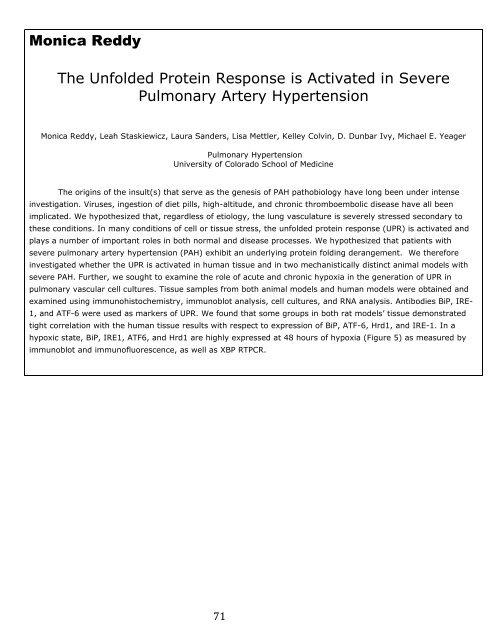student research day - Case Western Reserve University School of ...
student research day - Case Western Reserve University School of ...
student research day - Case Western Reserve University School of ...
You also want an ePaper? Increase the reach of your titles
YUMPU automatically turns print PDFs into web optimized ePapers that Google loves.
Monica Reddy<br />
The Unfolded Protein Response is Activated in Severe<br />
Pulmonary Artery Hypertension<br />
Monica Reddy, Leah Staskiewicz, Laura Sanders, Lisa Mettler, Kelley Colvin, D. Dunbar Ivy, Michael E. Yeager<br />
Pulmonary Hypertension<br />
<strong>University</strong> <strong>of</strong> Colorado <strong>School</strong> <strong>of</strong> Medicine<br />
The origins <strong>of</strong> the insult(s) that serve as the genesis <strong>of</strong> PAH pathobiology have long been under intense<br />
investigation. Viruses, ingestion <strong>of</strong> diet pills, high-altitude, and chronic thromboembolic disease have all been<br />
implicated. We hypothesized that, regardless <strong>of</strong> etiology, the lung vasculature is severely stressed secondary to<br />
these conditions. In many conditions <strong>of</strong> cell or tissue stress, the unfolded protein response (UPR) is activated and<br />
plays a number <strong>of</strong> important roles in both normal and disease processes. We hypothesized that patients with<br />
severe pulmonary artery hypertension (PAH) exhibit an underlying protein folding derangement. We therefore<br />
investigated whether the UPR is activated in human tissue and in two mechanistically distinct animal models with<br />
severe PAH. Further, we sought to examine the role <strong>of</strong> acute and chronic hypoxia in the generation <strong>of</strong> UPR in<br />
pulmonary vascular cell cultures. Tissue samples from both animal models and human models were obtained and<br />
examined using immunohistochemistry, immunoblot analysis, cell cultures, and RNA analysis. Antibodies BiP, IRE-<br />
1, and ATF-6 were used as markers <strong>of</strong> UPR. We found that some groups in both rat models’ tissue demonstrated<br />
tight correlation with the human tissue results with respect to expression <strong>of</strong> BiP, ATF-6, Hrd1, and IRE-1. In a<br />
hypoxic state, BiP, IRE1, ATF6, and Hrd1 are highly expressed at 48 hours <strong>of</strong> hypoxia (Figure 5) as measured by<br />
immunoblot and immun<strong>of</strong>luorescence, as well as XBP RTPCR.<br />
71
















